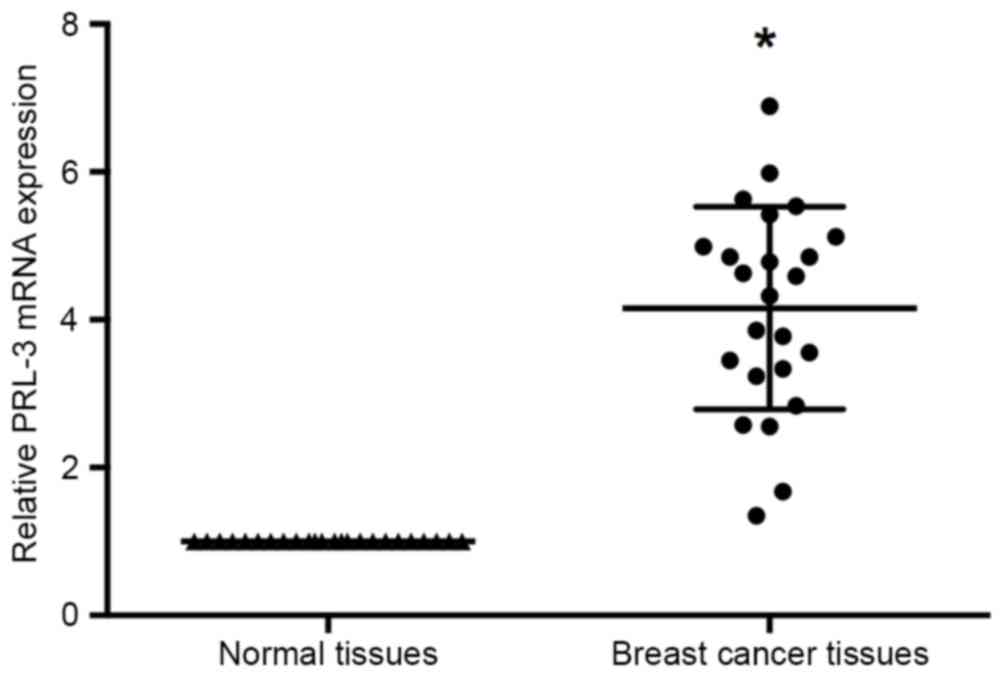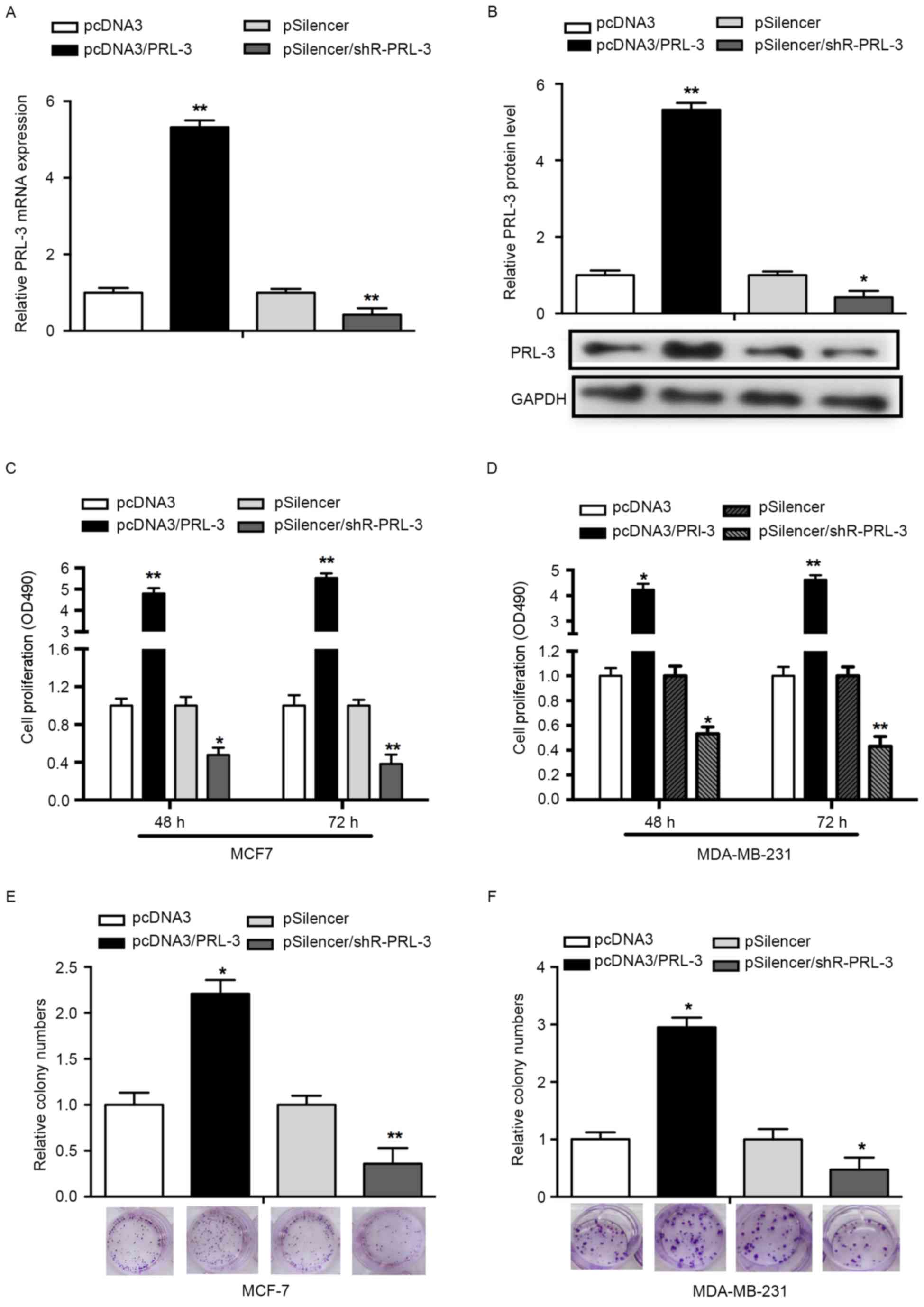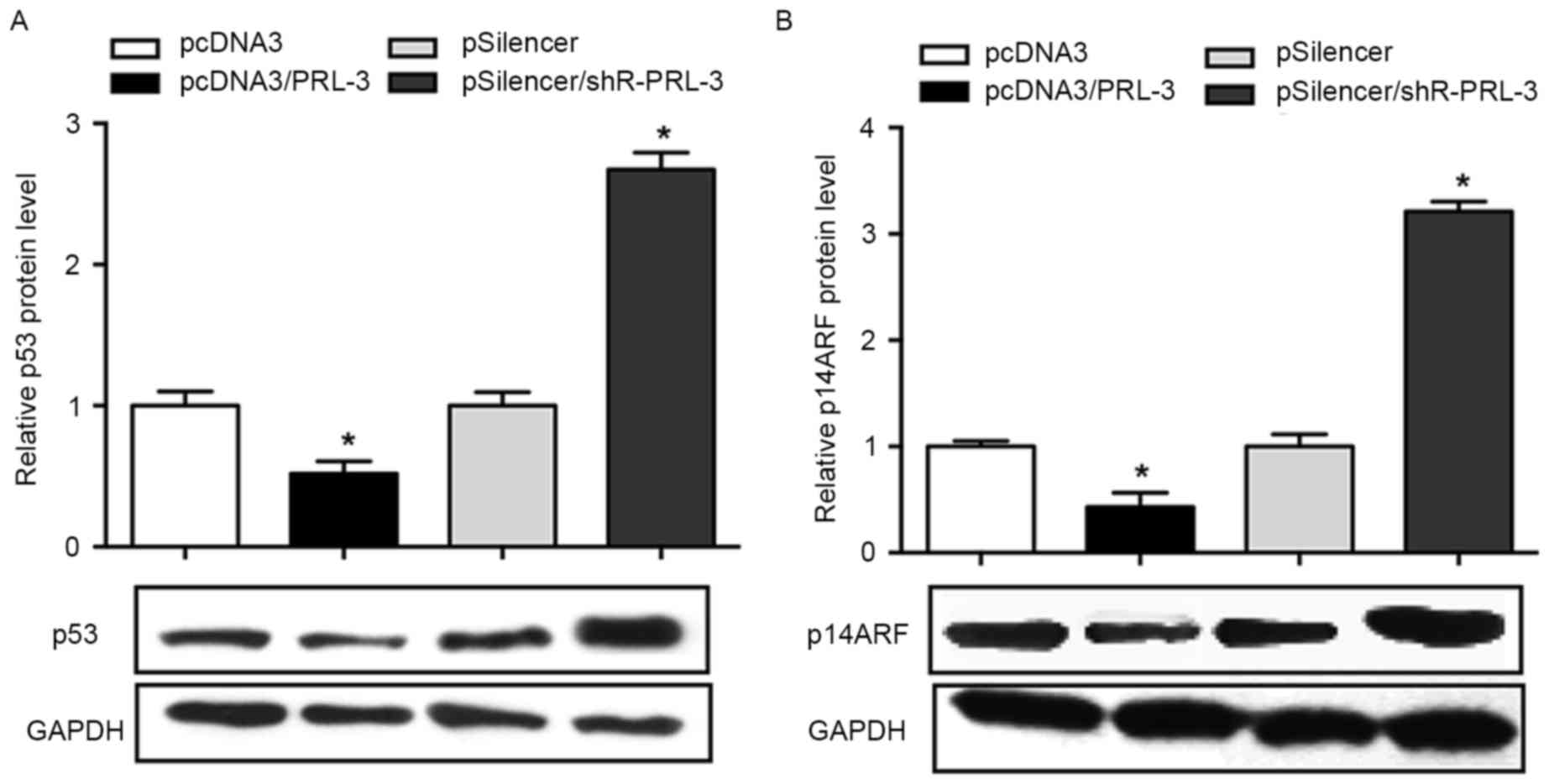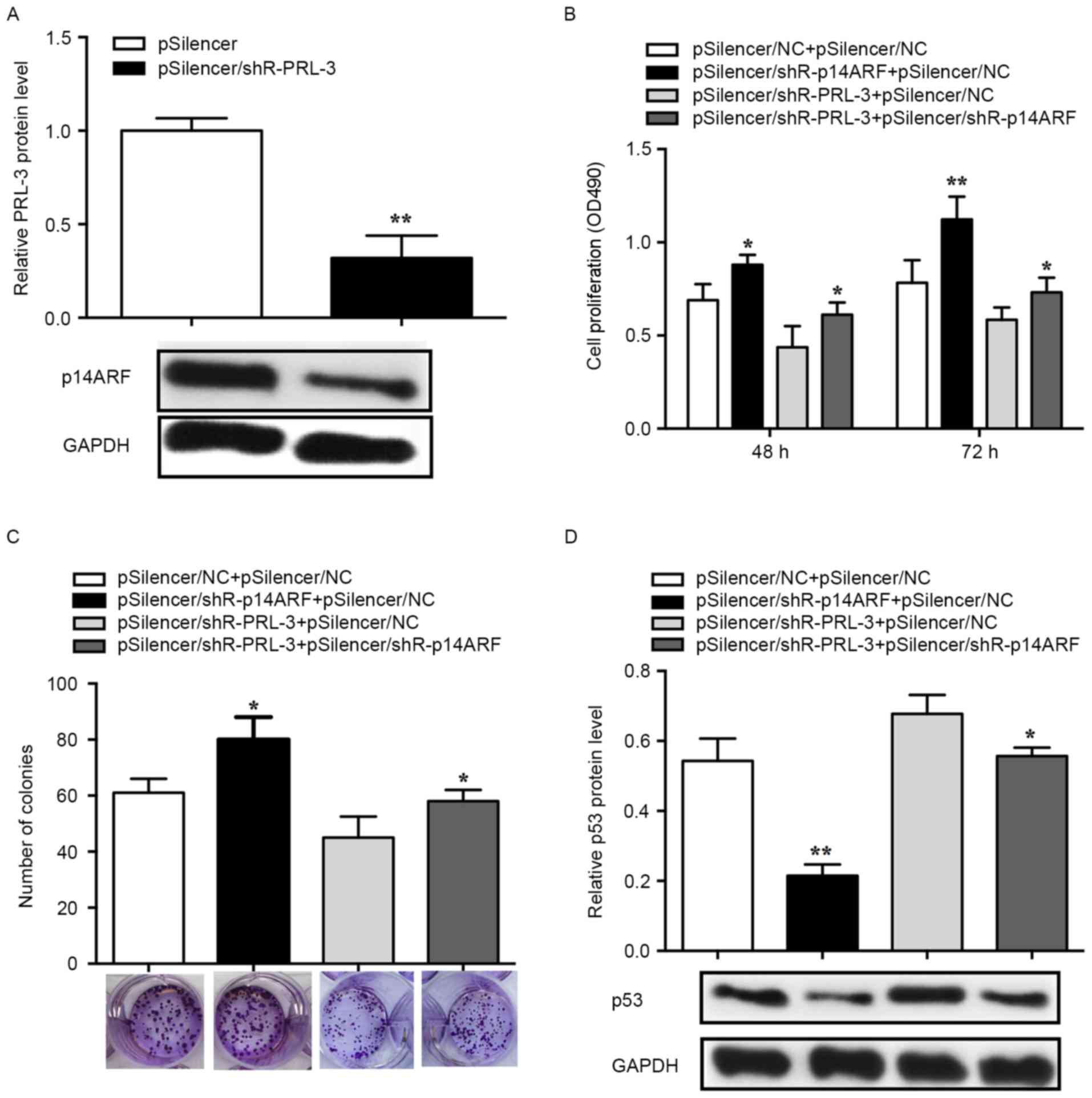|
1
|
McGuire A, Brown JA, Malone C, McLaughlin
R and Kerin MJ: Effects of age on the detection and management of
breast cancer. Cancers (Basel). 7:908–929. 2015. View Article : Google Scholar : PubMed/NCBI
|
|
2
|
Youlden DR, Cramb SM, Dunn NA, Muller JM,
Pyke CM and Baade PD: The descriptive epidemiology of female breast
cancer: An international comparison of screening, incidence,
survival and mortality. Cancer Epidemiol. 36:237–248. 2012.
View Article : Google Scholar : PubMed/NCBI
|
|
3
|
Zhou J, Cheong LL, Liu SC, Chong PS,
Mahara S, Bi C, Ong KO, Zeng Q and Chng WJ: The pro-metastasis
tyrosine phosphatase, PRL-3 (PTP4A3), is a novel mediator of
oncogenic function of BCR-ABL in human chronic myeloid leukemia.
Mol Cancer. 11:722012. View Article : Google Scholar : PubMed/NCBI
|
|
4
|
Stephens BJ, Han H, Gokhale V and Von Hoff
DD: PRL phosphatases as potential molecular targets in cancer. Mol
Cancer Ther. 4:1653–1661. 2005. View Article : Google Scholar : PubMed/NCBI
|
|
5
|
Kato H, Semba S, Miskad UA, Seo Y, Kasuga
M and Yokozaki H: High expression of PRL-3 promotes cancer cell
motility and liver metastasis in human colorectal cancer: A
predictive molecular marker of metachronous liver and lung
metastases. Clin Cancer Res. 10:7318–7328. 2004. View Article : Google Scholar : PubMed/NCBI
|
|
6
|
Mollevi DG, Aytes A, Padullés L,
Martínez-Iniesta M, Baixeras N, Salazar R, Ramos E, Figueras J,
Capella G and Villanueva A: PRL-3 is essentially overexpressed in
primary colorectal tumours and associates with tumour
aggressiveness. Br J Cancer. 99:1718–1725. 2008. View Article : Google Scholar : PubMed/NCBI
|
|
7
|
Miskad UA, Semba S, Kato H and Yokozaki H:
Expression of PRL-3 phosphatase in human gastric carcinomas: Close
correlation with invasion and metastasis. Pathobiology. 71:176–184.
2004. View Article : Google Scholar : PubMed/NCBI
|
|
8
|
Wang Z, Cai SR, He YL, Zhan WH, Zhang CH,
Wu H, Peng JJ, Xu JB, Zhang XH, Wang L and Song W: Elevated PRL-3
expression was more frequently detected in the large primary
gastric cancer and exhibits a poor prognostic impact on the
patients. J Cancer Res Clin Oncol. 135:1041–1046. 2009. View Article : Google Scholar : PubMed/NCBI
|
|
9
|
Polato F, Codegoni A, Fruscio R, Perego P,
Mangioni C, Saha S, Bardelli A and Broggini M: PRL-3 phosphatase is
implicated in ovarian cancer growth. Clin Cancer Res. 11:6835–6839.
2005. View Article : Google Scholar : PubMed/NCBI
|
|
10
|
Liu H, Al-aidaroos AQ, Wang H, Guo K, Li
J, Zhang HF and Zeng Q: PRL-3 suppresses c-Fos and integrin α2
expression in ovarian cancer cells. BMC Cancer. 13:802013.
View Article : Google Scholar : PubMed/NCBI
|
|
11
|
Fagerli UM, Holt RU, Holien T, Vaatsveen
TK, Zhan F, Egeberg KW, Barlogie B, Waage A, Aarset H, Dai HY, et
al: Overexpression and involvement in migration by the
metastasis-associated phosphatase PRL-3 in human myeloma cells.
Blood. 111:806–815. 2008. View Article : Google Scholar : PubMed/NCBI
|
|
12
|
Ma Y and Li B: Expression of phosphatase
of regenerating liver-3 in squamous cell carcinoma of the cervix.
Med Oncol. 28:775–780. 2011. View Article : Google Scholar : PubMed/NCBI
|
|
13
|
Wang L, Peng L, Dong B, Kong L, Meng L,
Yan L, Xie Y and Shou C: Overexpression of phosphatase of
regenerating liver-3 in breast cancer: association with a poor
clinical outcome. Ann Oncol. 17:1517–1522. 2006. View Article : Google Scholar : PubMed/NCBI
|
|
14
|
Livak KJ and Schmittgen TD: Analysis of
relative gene expression data using real-time quantitative PCR and
the 2(-Delta Delta C(T)) method. Methods. 25:402–408. 2001.
View Article : Google Scholar : PubMed/NCBI
|
|
15
|
Ustaalioglu BB, Bilici A, Barisik NO,
Aliustaoglu M, Vardar FA, Yilmaz BE, Seker M and Gumus M: Clinical
importance of phosphatase of regenerating liver-3 expression in
breast cancer. Clin Transl Oncol. 14:911–922. 2012. View Article : Google Scholar : PubMed/NCBI
|
|
16
|
Min L, Ma RL, Yuan H, Liu CY, Dong B,
Zhang C, Zeng Y, Wang L, Guo JP, Qu LK and Shou CC: Combined
expression of metastasis related markers Naa10p, SNCG and PRL-3 and
its prognostic value in breast cancer patients. Asian Pac J Cancer
Prev. 16:2819–2826. 2015. View Article : Google Scholar : PubMed/NCBI
|
|
17
|
Sherr CJ: Principles of tumor suppression.
Cell. 116:235–246. 2004. View Article : Google Scholar : PubMed/NCBI
|
|
18
|
Procopio MG, Laszlo C, Al Labban D, Kim
DE, Bordignon P, Jo SH, Goruppi S, Menietti E, Ostano P, Ala U, et
al: Corrigendum: Combined CSL and p53 downregulation promotes
cancer-associated fibroblast activation. Nat Cell Biol.
17:13702015. View
Article : Google Scholar : PubMed/NCBI
|
|
19
|
Ma H, Lu Y, Malone KE, Marchbanks PA,
Deapen DM, Spirtas R, Burkman RT, Strom BL, McDonald JA, Folger SG,
et al: Mortality risk of black women and white women with invasive
breast cancer by hormone receptors, HER2 and p53 status. BMC
Cancer. 13:2252013. View Article : Google Scholar : PubMed/NCBI
|
|
20
|
Milojkovic A, Hemmati PG, Müer A, Overkamp
T, Chumduri C, Jänicke RU, Gillissen B and Daniel PT: p14ARF
induces apoptosis via an entirely caspase-3-dependent mitochondrial
amplification loop. Int J Cancer. 133:2551–2562. 2013.PubMed/NCBI
|
|
21
|
Silva J, Dominguez G, Silva JM, García JM,
Gallego I, Corbacho C, Provencio M, España P and Bonilla F:
Analysis of genetic and epigenetic processes that influence p14ARF
expression in breast cancer. Oncogene. 20:4586–4590. 2001.
View Article : Google Scholar : PubMed/NCBI
|
|
22
|
Maglic D, Zhu S, Fry EA, Taneja P, Kai F,
Kendig RD, Sugiyama T, Miller LD, Willingham MC and Inoue K:
Prognostic value of the hDMP1-ARF-Hdm2-p53 pathway in breast
cancer. Oncogene. 32:4120–4129. 2013. View Article : Google Scholar : PubMed/NCBI
|
|
23
|
Wazir U, Jiang WG, Yasaei H, Linne H,
Newbold RF and Mokbel K: P14ARF is down-regulated during tumour
progression and predicts the clinical outcome in human breast
cancer. Anticancer Res. 33:2185–2189. 2013.PubMed/NCBI
|
|
24
|
Xia L, Paik A and Li JJ: p53 activation in
chronic radiation-treated breast cancer cells: Regulation of
MDM2/p14ARF. Cancer Res. 64:221–228. 2004. View Article : Google Scholar : PubMed/NCBI
|
|
25
|
Wei J, Noto JM, Zaika E, Romero-Gallo J,
Piazuelo MB, Schneider B, El-Rifai W, Correa P, Peek RM and Zaika
AI: Bacterial CagA protein induces degradation of p53 protein in a
p14ARF-dependent manner. Gut. 64:1040–1048. 2015. View Article : Google Scholar : PubMed/NCBI
|
|
26
|
Wang J, Ding S, Duan Z, Xie Q, Zhang T,
Zhang X, Wang Y, Chen X, Zhuang H and Lu F: Role of p14ARF-HDM2-p53
axis in SOX6-mediated tumor suppression. Oncogene. 35:1692–1702.
2016. View Article : Google Scholar : PubMed/NCBI
|
|
27
|
Lv H, Liu R, Fu J, Yang Q, Shi J, Chen P,
Ji M, Shi B and Hou P: Epithelial cell-derived periostin functions
as a tumor suppressor in gastric cancer through stabilizing p53 and
E-cadherin proteins via the Rb/E2F1/p14ARF/Mdm2 signaling pathway.
Cell Cycle. 13:2962–2974. 2014. View Article : Google Scholar : PubMed/NCBI
|













